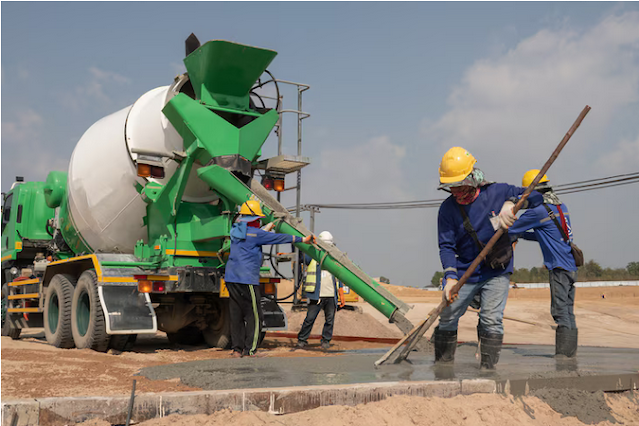Concrete Delivery: A Vital Component for Seamless Construction
Introduction
Concrete is the backbone of modern construction, providing the foundation for buildings, bridges, roads, and various infrastructure projects. Its versatility, durability, and strength make it an indispensable material in the construction industry. However, the success of any construction project relies not only on the quality of concrete but also on the efficiency of its delivery. Concrete delivery plays a vital role in ensuring seamless construction processes, timely project completion, and the overall success of the project. This essay explores the significance of concrete delivery, highlighting its role as a vital component for smooth and efficient construction.
Importance of Timely Concrete Delivery
Meeting Construction Schedules
Construction projects are subject to tight schedules and deadlines. Delayed concrete delivery can have a domino effect on the entire construction process, causing delays in subsequent tasks and impacting the overall project timeline. Timely concrete delivery is crucial to meeting construction schedules and avoiding costly delays.
Minimizing Project Costs
In the construction industry, time is money. Delayed concrete delivery can lead to increased labor costs and extended equipment rentals, both of which can significantly impact the project budget. By ensuring timely concrete delivery, construction companies can minimize project costs and improve their bottom line.
Efficient Resource Utilization
Timely concrete delivery allows for efficient resource utilization. Construction sites can plan their activities more effectively when they know that concrete will be delivered on schedule. This optimization of resources leads to better productivity and reduces waste, contributing to a more sustainable construction process.
Factors Affecting Concrete Delivery
Proximity to Batching Plant
The distance between the construction site and the concrete batching plant is a critical factor in determining delivery time. Construction projects located closer to the plant typically benefit from quicker delivery times and reduced transportation costs.
Traffic and Road Conditions
Traffic congestion and road conditions can significantly impact concrete delivery schedules. Construction companies must consider potential traffic bottlenecks and plan deliveries accordingly to avoid delays.
Weather Conditions
Adverse weather conditions, such as heavy rain or extreme temperatures, can impact the workability and setting time of concrete. Construction teams must coordinate with the concrete supplier to adjust delivery schedules based on weather forecasts.
Concrete Pumping
For construction sites with challenging access or higher elevations, concrete pumping may be required to deliver the concrete to the desired location. Incorporating concrete pumping into the delivery process requires careful planning and coordination.
Benefits of Efficient Concrete Delivery
Improved Construction Efficiency
Efficient concrete delivery streamlines the construction process, allowing construction teams to work smoothly and systematically. When concrete is delivered on time, tasks can be completed in sequence, avoiding unnecessary downtime and bottlenecks.
Enhanced Project Safety
Timely concrete delivery contributes to a safer construction site. When concrete is readily available, there is less pressure on workers to rush tasks, reducing the risk of accidents and injuries.
Higher Quality Concrete
Efficient concrete delivery ensures that the concrete is fresh and meets the required specifications. Fresh concrete has better workability and setting properties, leading to higher quality construction.
Increased Customer Satisfaction
For construction companies, timely project completion and efficient delivery are crucial for maintaining positive client relationships. Meeting project deadlines and delivering high-quality work enhance customer satisfaction and lead to repeat business and referrals.
Concrete Delivery Methods
Ready Mix Concrete Delivery
Ready mix concrete delivery involves the use of pre-mixed concrete produced at a batching plant. The concrete is transported to the construction site using specialized trucks equipped with rotating drums to keep the concrete fresh during transit. Ready mix concrete delivery offers the advantage of consistent quality, precise mix design, and timely delivery.
On-Site Concrete Mixing
On-site concrete mixing involves the manual mixing of concrete components directly at the construction site. While this method provides flexibility in adjusting mix designs, it can be labor-intensive and time-consuming. On-site concrete mixing is more commonly used for small-scale projects or in remote areas with limited access to ready mix concrete suppliers.
Concrete Pumping
Concrete pumping is a method used to deliver concrete to challenging or elevated locations on the construction site. It involves using pumps and hoses to transport the concrete from the delivery truck to the desired location. Concrete pumping is particularly useful for high-rise buildings, tunnels, and areas with restricted access.
Conclusion
Concrete delivery is a vital component of seamless construction, ensuring the timely and efficient placement of this essential building material. Timely concrete delivery is crucial for meeting construction schedules, minimizing project costs, and optimizing resource utilization. Factors such as proximity to the batching plant, traffic and road conditions, weather, and concrete pumping play significant roles in determining delivery efficiency. By ensuring efficient concrete delivery, construction companies can improve construction efficiency, enhance project safety, deliver higher quality work, and increase customer satisfaction. Ultimately, recognizing the importance of concrete delivery and choosing the most appropriate delivery method contribute to the success of construction projects and the creation of enduring structures that shape the world around us.




Comments
Post a Comment